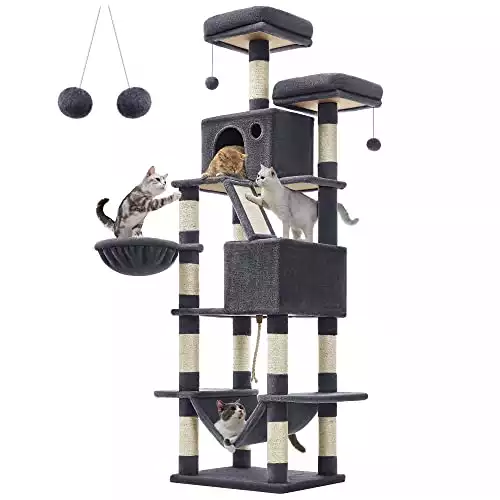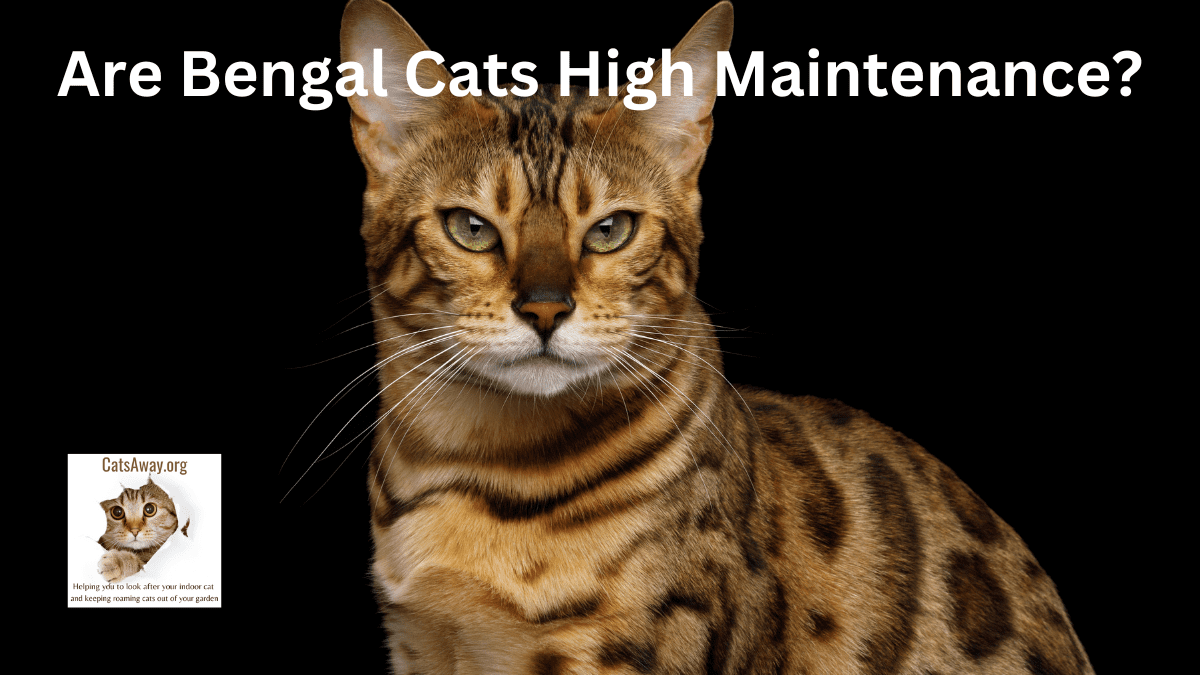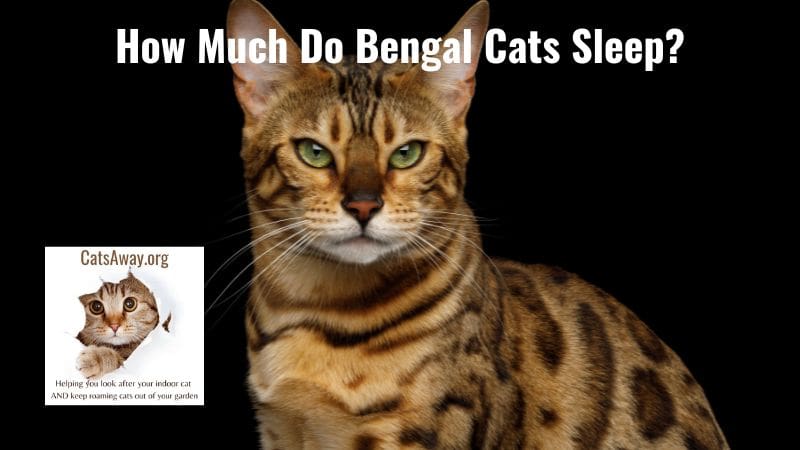Bengal cats are known for their exotic appearance and delightful personalities. However, these intelligent felines can sometimes exhibit behavior problems that may puzzle or challenge their owners.
Some common issues related to Bengal cat behavior include destructiveness when bored, being fussy about their litter box, and their inexhaustible curiosity. Their intelligence and hyperactivity can make them more mischievous compared to other cat breeds.
Understanding and addressing these Bengal cat personality problems is key to maintaining a harmonious relationship between Bengal cats and their owners. This article will explore Bengal cat personality traits and offer helpful tips to manage their quirks.
Bengal Cat Personality Traits
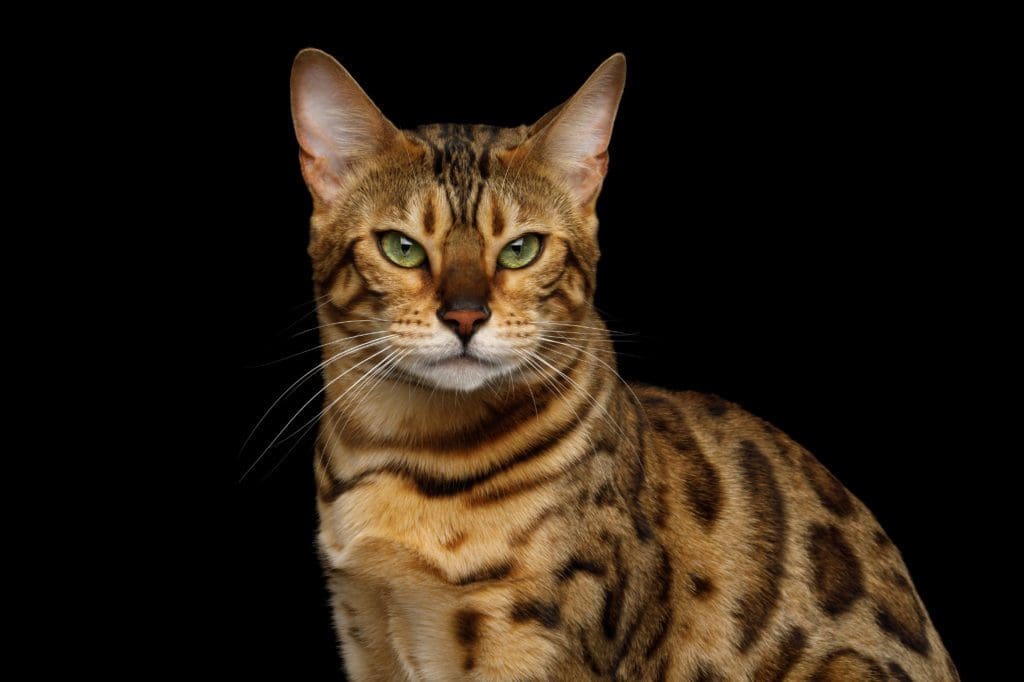
Intelligence and Curiosity
Bengal cats are known for their intelligence and curiosity, always eager to explore their surroundings. They have the capacity to learn quickly which makes them a fascinating breed to interact with.
Energetic and Playful
They possess a high energy level, thriving on playtime and physical activities. Their spirited nature makes them an entertaining companion, as they constantly seek new ways to stay engaged. Although they do make exceptional indoor cats the Bengal is not a pet for those looking for a laid back, take it or leave it personality!
Affectionate and Social
Bengal cats form a strong bond with their human companions and are known for their affectionate and social nature. They enjoy being around people, often following their owners around and seeking their attention.
Talkative and Vocal
Bengal cats exhibit a talkative and vocal demeanor. They are known to communicate with their owners using distinct vocalizations, making them an expressive breed to have as a pet.
In summary, Bengal cat personality traits include intelligence, curiosity, energetic and playful behavior, affectionate and social tendencies, and talkative and vocal communication. These characteristics make them unique and captivating pets to have around.
Common Bengal Cat Behavior Problems
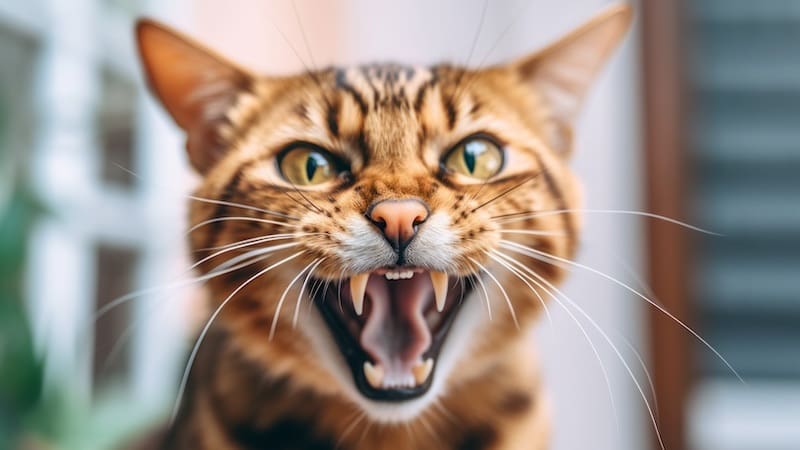
Aggression and Territorial Tendencies
Bengal cats can display aggression and territorial tendencies more often than other breeds. This is due to their wild ancestry that contributes to their strong instincts to defend their territory.
Hyperactivity and Restlessness
These energetic felines are naturally hyperactive and restless, which may lead to certain behavior problems. They require constant mental and physical stimulation to stay content and well-behaved.
Scratching and Biting Furniture
Scratching cat behavior is common in Bengals as they have a strong need to satisfy their natural instincts, which can include scratching and biting furniture. Providing them with appropriate scratching posts and toys can help redirect their attention and prevent damage to household items.
Excessive Meowing and Vocalization
Bengals are known for their loud and consistent vocalizations, which can sometimes be excessive. This meowing may indicate boredom or a need for attention, so it’s important to ensure that they have plenty of interactive toys and regular playtime sessions.
Separation Anxiety
Due to their loyal nature, Bengals may develop separation anxiety if left alone for extended periods. This can result in destructive behaviors and excessive vocalization. To minimize separation anxiety, owners should establish a consistent daily routine and provide enough enrichment to keep their Bengal cats entertained.
Addressing Behavior Problems
Proper Exercise and Playtime
Engaging them in playtime using toys, puzzles, and interactive games can help maintain their physical and mental well-being.
Socialization and Routine
These active felines often face issues like depression and separation anxiety, which can be alleviated through consistent socialization and a stable routine. Regularly exposing them to new people, environments, and other pets can help develop their social skills and reduce the likelihood of behavioral issues.
Training and Rewards
Bengal cats are intelligent and trainable, and they respond positively to rewards-based training methods, which can help manage unwanted behaviors. Utilizing treats and praise as reinforcements, owners can encourage good behavior while also strengthening the bond with their Bengal cat.
Preventing Boredom
Bengal cats are prone to destructive scratching behaviors when bored, which can often be mitigated by providing a stimulating environment. Using puzzle toys, interactive feeders, and rotating playthings can help keep their minds engaged and minimize the chances of them acting out.
Purchasing a cat exercise wheel is a wise investment as it provides endless entertainment as well as keeping them healthy.
By incorporating regular physical activity, consistent socialization, rewards-based training, and activities to keep them engaged, owners can take essential steps to address Bengal cat behavior problems effectively.
Creating a Bengal-Friendly Environment
Interactive Toys and Cat Trees
Bengal cats thrive in an environment with engaging toys and climbing structures. Providing new and interactive toys, such as electronic fish, can help stimulate their curiosity. Cat trees with shelves and sleeping boxes can give them a place to climb and explore, satisfying their natural instincts and athletic tendencies.
If you want a tall cat tree that fits medium to large cats with various features and sturdy construction, this is the cat tree is for you.
Ideal for cats who like to sleep in high spots as it features two sleeping boxes and a hammock for those daytime naps.
- 81.1" tall with 5 levels for endless climbing
- A total of 13 scratching posts
- Includes spare hanging balls which is a nice touch
- All-in-one playground that can handle multiple cats
- Durable and safe structure with anti-tip kit
- Modern dark Grey color
- Easy to clean
- Included step by step instructions and all parts are numbered for easy assembly
Safe Room and Perches
Ensure your Bengal cat has a safe room where they can retreat and feel secure from any perceived threats. Additionally, installing window perches allows them to maintain a visual connection with the outside world, contributing to their mental well-being.
Outdoor Time
Bengal cats are not cheap so you will not want your pet roaming freely where they can catch diseases from other cats, eat poisoned vermin, get into fights with other felines or local wildlife. Indoor cats generally live up to 5 times longer than a cat that is free to roam.
However if you want to go one better than a window perch, you do have a couple of options to give your precious pet some genuine outdoor time. The Bengal is highly intelligent and quickly takes to cat harness training so you can allow him out while under your supervision.
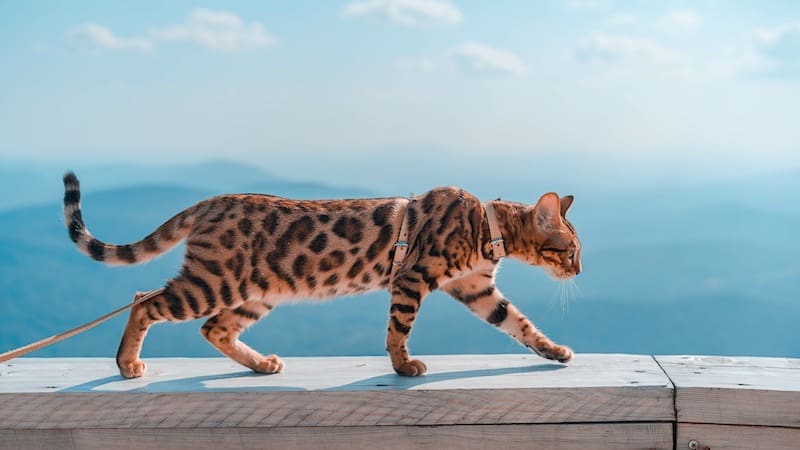

A second option, if you have a patio area, is to provide a catio enclosure so he can safely spend some time outside without any risk of going wandering. A catio fixes against any wall with a window so your cat has access when you open the window.
This allows your Bengal cat to go outside to enjoy the view and fresh air unsupervised whenever he likes during the day.
This cat enclosure has a removable back panel so you can connect it up against a window allowing your cat can come and go as he pleases.
There are a total of 7 platforms connecting from left to right for your cat to climb on.
It has 2 large sleeping houses and a waterproof roof to keep the enclosure dry.
This is a very sturdy design and will cope with all weathers.
Litter Box Considerations
Litter box placement is crucial for Bengal cats. Make sure to provide multiple clean and spacious litter boxes, preferably placed in low-traffic areas of your home. This will allow your Bengal cat to eliminate comfortably without feeling vulnerable or disturbed.
Feeding and Nutrition
A well-balanced diet is essential for a healthy Bengal cat. Offer high-quality, protein-rich cat food specifically created for indoor cats to support their energetic lifestyle. Be mindful of portion control and feeding times, as consistent routines can help reduce Bengal cat behavior problems.
Bengal Cat Breed Overview
History and Origin


The Bengal cat is a hybrid breed created by crossing domestic cats with the wild Asian leopard cat. This breed originated in the United States and has gained popularity due to its unique appearance and personality.
Appearance and Coat
Bengal cats are known for their striking coat patterns, which resemble those of their wild ancestors. They often have a golden or silver base coat adorned with dark spots or marbled patterns.
Size and Weight
Bengal cats are considered a large domestic breed, with adult males typically weighing between 12-22 pounds and females weighing slightly less. Its size contributes to its athletic and energetic nature.
Height and Athletic Build
With a height ranging from 14 to 18 inches, Bengal cats have a sleek, muscular build. Their athletic abilities make them excellent jumpers and climbers, requiring ample space to explore and play.
Lifespan
The typical lifespan for indoor Bengal cats is 10-15 years. Proper care, including a well-balanced diet and regular veterinarian checkups, can contribute to a healthy and happy life for these cats.
Bengal Cat Health Concerns
Bengal cats are generally a healthy breed, but they can be prone to specific genetic health issues. In this section, we’ll discuss three major concerns: Hypertrophic Cardiomyopathy, Progressive Retinal Atrophy, and Genetic Kidney Disease.
Hypertrophic Cardiomyopathy
Hypertrophic Cardiomyopathy (HCM) is a heart disease that can affect Bengal cats. It causes the walls of the heart to thicken, reducing its efficiency and potentially leading to heart failure. Bengal cats should be regularly screened for HCM to increase the likelihood of early detection and treatment.
Progressive Retinal Atrophy
Progressive Retinal Atrophy (PRA) is an inherited eye disease that can cause blindness in Bengal cats. This condition gradually degrades the retina, resulting in a loss of vision over time.
PRA is a known health issue in Bengal cats, and it is important to have your Bengal cat screened for the disease if you are considering breeding or adopting one. If you are purchasing your Bengal kitten from a reputable breeder they should be able to provide screening results for you.
Early diagnosis of PRA is essential, as it can help prevent further deterioration and manage the condition more effectively.
Genetic Kidney Disease
Bengal cats can suffer from PKD (Polycystic Kidney Disease), but it is not as common in Bengal cats as it is in Persian cats. PKD is an inherited disease that causes abnormal cysts to form in a cat’s kidneys, and it can lead to kidney failure.
According to Cats.com (source: Cats.com), PKD is not common in Bengal cats, but it is still important to have your Bengal cat screened for the disease if you are considering breeding or adopting one. It’s also worth noting that PKD is different from PK-def (Pyruvate Kinase Deficiency), which is a genetic condition that affects the red blood cells of Bengal cats.
PKD causes cysts to form in the kidneys, and if left untreated, it can result in kidney failure. Symptoms may not appear until later in the cat’s life, making early diagnosis of PKD crucial for prompt treatment and proper care.
Frequently Asked Questions
Why do Bengal cats bite?
Bengal cats may bite due to various reasons such as overstimulation, playfulness, or feeling threatened. Providing appropriate toys and training can help redirect their biting behavior.
How to discipline a Bengal cat?
To discipline a Bengal cat, use positive reinforcement techniques like offering treats, praise, or toys when they display good behavior. Avoid punishment, as it can lead to fear or aggression.
What are Bengal cat behavior issues?
Some common behavior issues in Bengal cats include excessive meowing, scratching furniture, and play biting. Addressing their needs, like sufficient exercise and mental stimulation, can help mitigate these issues.
Are Bengal cats prone to aggression?
Bengal cats are not inherently aggressive but may display aggressive behavior if they feel threatened or have unmet needs. Socializing and stimulating them mentally and physically can reduce the likelihood of aggression.
Why are Bengal cats illegal in some places?
As far as I know, no American states have outright banned Bengal cats. However, some states may have restrictions on owning exotic animals, which could include Bengal cats due to their hybrid origin from wild Asian leopard cats, generating concerns about their impact on local ecosystems.
It’s important to check with your local government to see if there are any specific laws or regulations regarding the ownership of Bengal cats in your area. Regulations vary depending on the specific location.
Do Bengal cats have unique challenges?
Yes, Bengal cats have unique challenges due to their high energy levels, intelligence, and curiosity. They require frequent mental stimulation and physical activity to prevent behavioral problems and maintain overall well-being.


